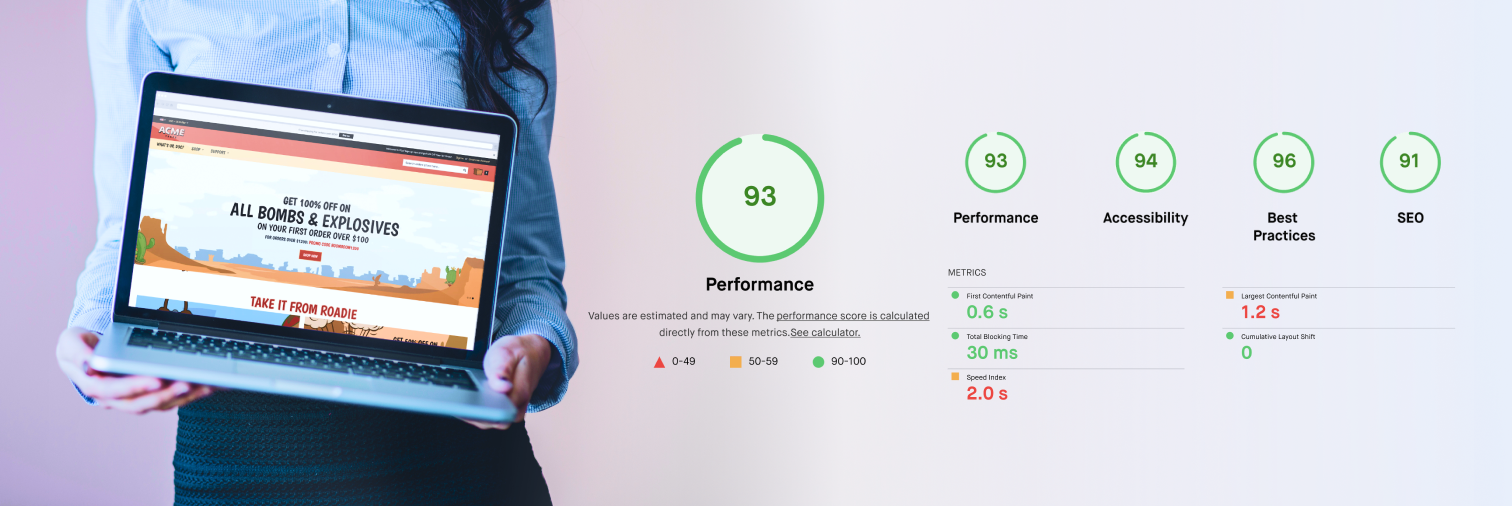
When building a large eCommerce storefront, speed, flexibility, and experience aren’t just nice-to-haves—they’re expected. Legacy platforms can’t always keep up with modern demands for rapid performance and design flexibility. That’s where Flux Commerce steps in.
Flux is Binary Anvil’s proprietary headless commerce platform designed to future-proof your digital storefront. Whether you're looking to scale, redesign, or improve your site’s speed and flexibility, Flux helps brands break free from traditional platform limitations.
Let’s take a closer look at what makes Flux different—and how it helped G.A. Precision (GAP) elevate their eCommerce experience.
What Is Flux Commerce?
Flux is a fully decoupled, headless frontend for Adobe Commerce and BigCommerce. Built using React, Next.js, and i18next, Flux connects to your eCommerce backend via GraphQL APIs. The result? A lightning-fast, highly customizable experience that keeps your frontend agile while your backend handles the heavy lifting.
Flux was designed with scalability, performance, and total creative freedom in mind. For brands that are ready to leave behind templated, slow-loading storefronts, Flux unlocks new possibilities.
What Makes Flux Unique?
Speed & Performance
Flux is built to be fast—period. From page load speeds to Core Web Vitals, Flux helps ensure your site’s performance matches the expectations of modern shoppers (and search engines).
Frontend Flexibility
Tired of one-size-fits-all themes? With Flux, developers and designers have complete control over the look and feel of the site, without being tied to backend code structures.
API-First Architecture
By using GraphQL and an API-first model, Flux makes it easy to connect third-party tools, fetch real-time data, and ensure a seamless experience across platforms.
Simplified Upgrades
Because the frontend and backend are decoupled, platform updates no longer risk breaking your UI. This reduces downtime, dev hours, and long-term cost of ownership.
Why Headless Commerce Matters Now
Headless commerce isn’t just a trend—it’s a strategy for scale.
- Scalability: Need to launch a new brand, region, or channel? A headless setup lets you reuse your backend while building unique frontends as needed.
- Customization: Control every pixel of the frontend to deliver tailored experiences to your customers.
- Omnichannel: Extend your backend to power mobile apps, marketplaces, kiosks, and more—all from one centralized system.
- Futureproofing: Swap out tools and frontend frameworks without ripping out your entire commerce platform.
Case Study: G.A. Precision (GAP)
The Challenge
G.A. Precision needed to move off an outdated Magento 2.2 site. Their goals were clear:
- Upgrade to the latest Adobe Commerce version.
- Improve site performance and UX.
- Market new product lines more effectively.
- Fix years of disorganized product data.
They also recognized the growing need for a site that blended content and commerce while delivering a high-performance experience for their loyal customer base.
Our Solution: Flux Commerce
G.A. Precision selected Binary Anvil’s Flux platform for its flexibility and speed. The decoupled architecture gave them a clean slate on the frontend while maintaining the robust commerce features of Adobe Commerce on the backend.
Flux enabled:
- Modern UX with React/Next.js
- Simplified data syncing through GraphQL
- Faster development and lower ongoing maintenance costs
What We Did
01. Ecommerce Re-Platform to Headless (Flux)
Rebuilt GAP’s site on the latest version of Adobe Commerce with a Flux-powered frontend. This ensured a stable, scalable backend and a highly flexible UI layer.
02. Website Redesign
A complete redesign elevated UX and brought the brand to life visually while improving usability across devices
03. Enhanced Catalog Architecture
We overhauled the catalog structure, cleaned up product attributes, and created a more intuitive shopping experience—both for the customer and the admin team.
04. Custom Navigation
Introduced dynamic ad spaces in the nav that change based on category. We also added thumbnail images to deep menu levels for a richer browse experience.
05. Testimonials & Gallery Page
We built a fully custom testimonial and gallery page where customers can share stories and upload images—managed entirely within the Adobe Commerce admin.
06. Form Builder Integration
GAP can now create custom forms anywhere on the site, giving their team a powerful lead-gen and data collection tool without the need for developers.
07. Custom PDP/PLP Layouts
We built unique product page layouts specifically for GAP’s high-end custom rifles, using full-width galleries and detail-focused design to elevate product presentation.
The Outcome
- Improved page speed and performance
- Streamlined admin workflows
- Custom UX features tailored to GAP’s customer base
- A flexible platform ready for future growth
Why We Built Flux
Over years of working with Adobe Commerce and BigCommerce clients, we saw a pattern: brands were being held back by rigid frontend limitations. They wanted speed, control, and differentiation—without blowing up their backend infrastructure.
Flux was built to meet that demand. It gives dev teams the flexibility they need, while empowering marketers to move faster and create better customer experiences.
Choosing the right platform isn’t always straightforward. In Week 3, we’ll dive into a detailed comparison of Adobe Commerce vs. BigCommerce to help you determine which enterprise platform fits your business goals.
Want to See Flux in Action?
Whether you’re replatforming or just looking to modernize your frontend, Flux gives you a flexible foundation to build on.


Comments
Add new comment